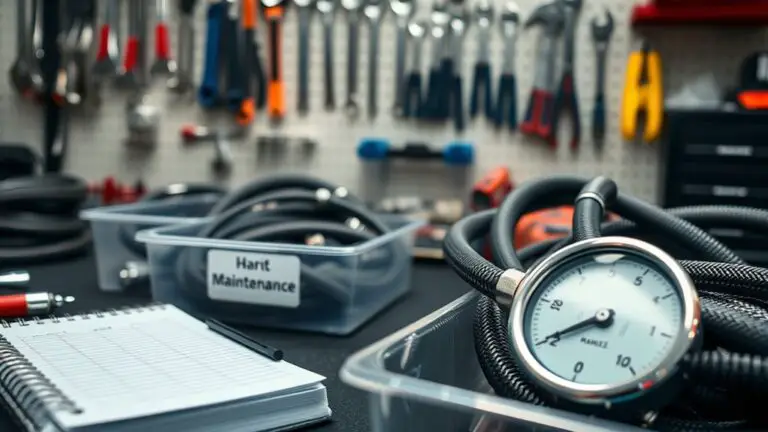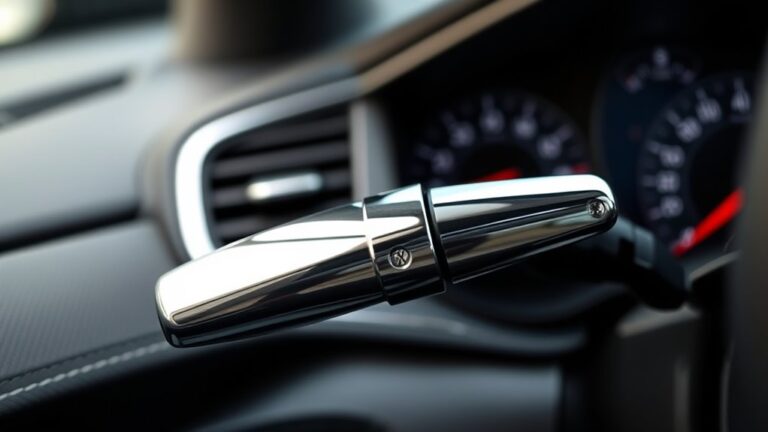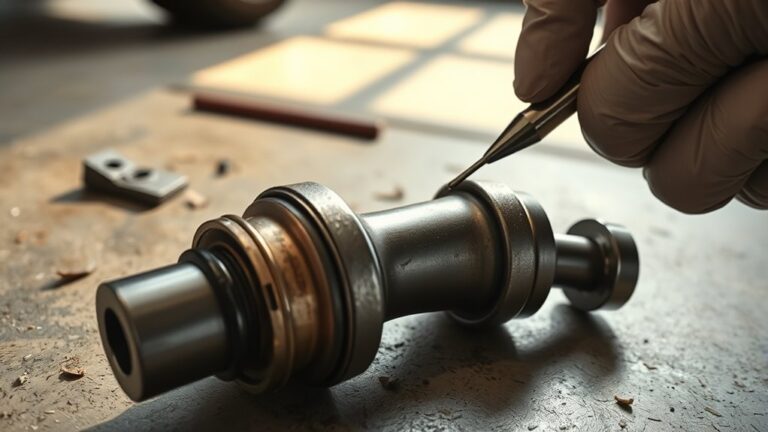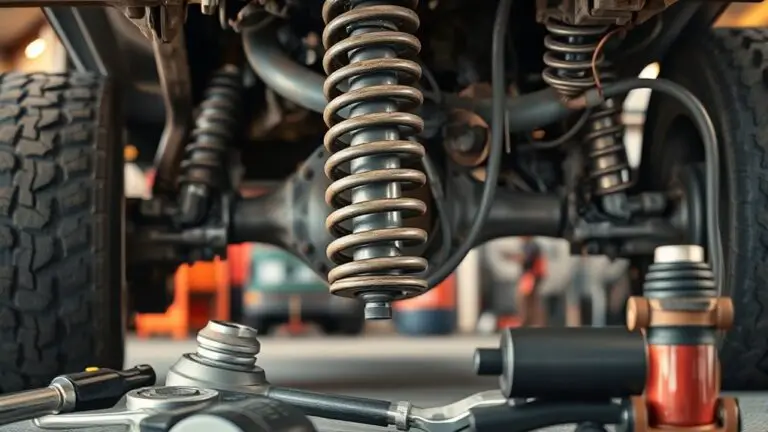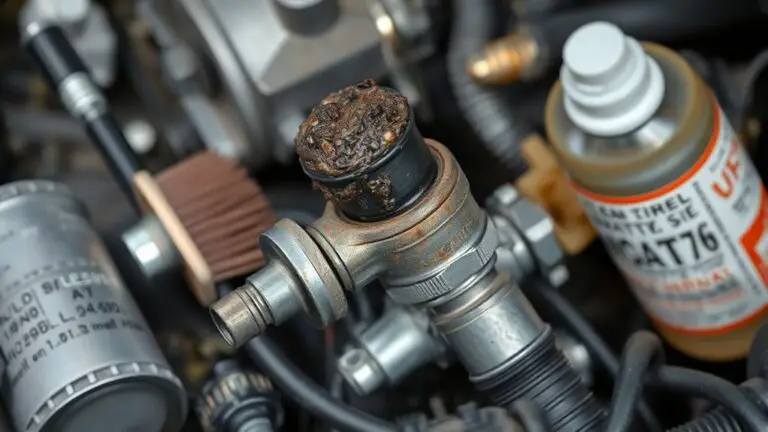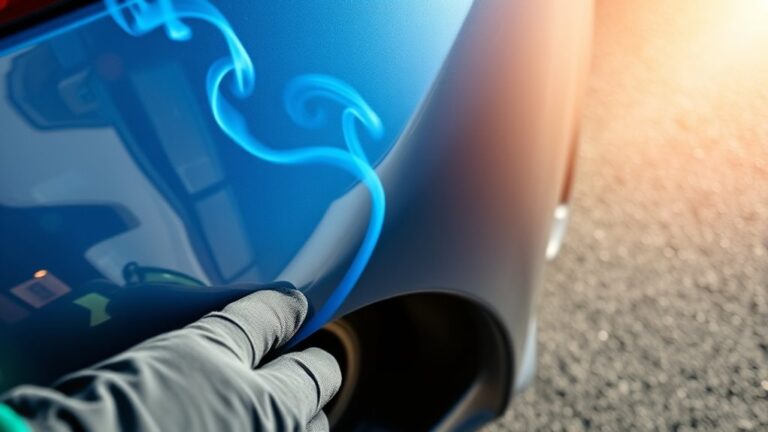How Temperature and Usage Cause Overheating Brakes and Prevention Tips
Brakes overheat due to high temperatures and excessive usage, especially from heavy traffic, aggressive driving, or prolonged downhill driving. This heat results from friction converting kinetic energy, making it essential to maintain effective friction materials and cooling systems. Signs like a spongy pedal, reduced performance, or unusual smells indicate distress. To prevent overheating, regularly check your brake fluid, use lower gears on inclines, and adopt smooth driving habits. Discover more ways to enhance your brake system’s performance.
Understanding Brake Functionality and Heat Generation
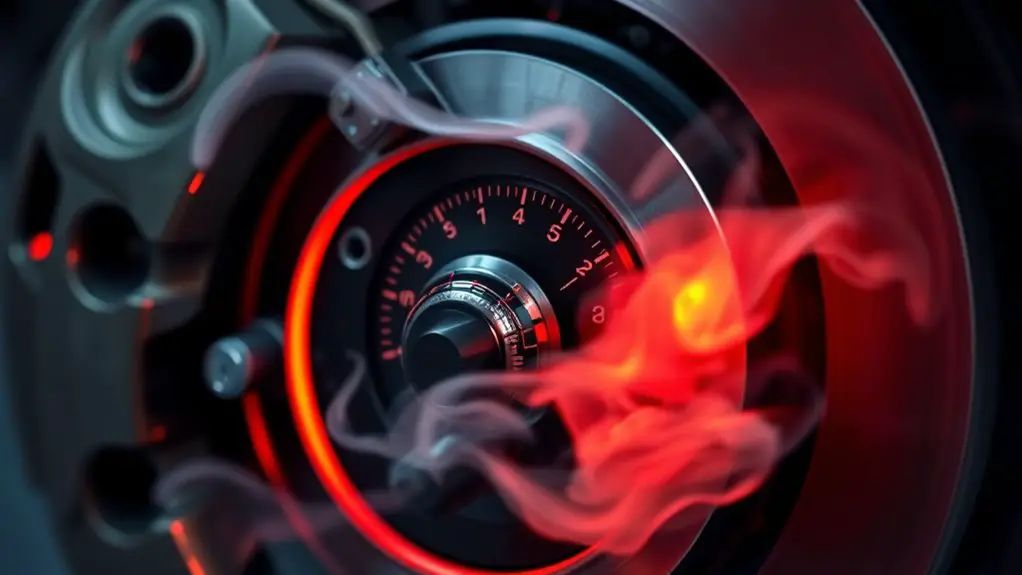
Braking systems are fundamental for vehicle safety, yet they generate significant heat during operation. Understanding brake functionality involves recognizing the interplay between brake design and friction materials. When you apply the brakes, kinetic energy converts into thermal energy through friction, which is essential for deceleration. The design of your braking system directly influences how efficiently heat dissipates.
High-performance friction materials can withstand greater temperatures, enhancing braking effectiveness and longevity. However, inferior materials may lead to excessive heat build-up, compromising safety and performance. It’s critical to choose the right combination of brake components tailored to your driving style and conditions.
Regularly checking your brake system guarantees that the friction materials remain effective and that the overall brake design functions at its best, preventing unnecessary heat generation. Understanding these elements empowers you to make informed decisions, enhancing both your vehicle’s safety and your driving experience.
Factors Contributing to Brake Overheating
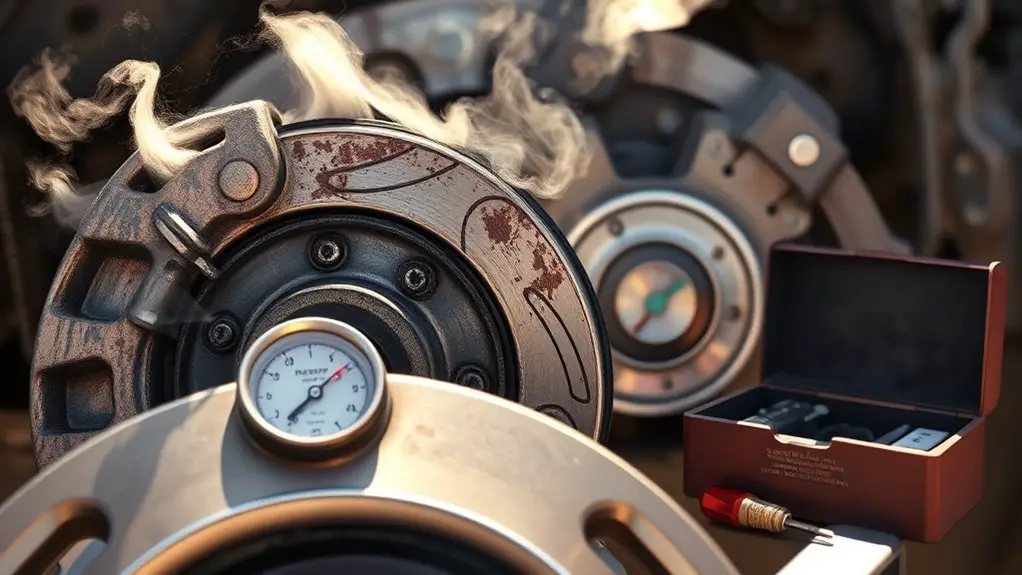
Several factors can lead to brake overheating, with high ambient temperatures being a primary concern. When you’re frequently applying brakes, whether in heavy traffic or during steep descents, the excessive usage greatly increases the heat generated. Understanding these conditions is essential for maintaining ideal brake performance and preventing potential failure.
High Ambient Temperatures
When driving in high ambient temperatures, the risk of brake overheating greatly increases, as heat dissipation becomes less effective. Ambient heat notably raises the thermal effects on brake components, causing them to reach critical temperatures more quickly. The brake fluid can boil, leading to vapor lock, while the friction materials may degrade, resulting in reduced stopping power. Additionally, the metal parts can expand, altering the fit and function of the braking system. To mitigate these risks, you should guarantee proper ventilation around the brakes and consider using high-performance materials designed to withstand elevated temperatures. Awareness of ambient conditions and proactive maintenance can help you maintain your freedom on the road without compromising safety.
Excessive Braking Usage
Excessive braking usage can greatly elevate the risk of brake overheating, particularly in scenarios involving frequent stops or prolonged downhill driving. Your driving habits directly influence brake pad wear and can lead to diminished braking performance. Understanding how your actions affect brake temperature is essential for maintaining safety and efficiency.
| Driving Habit | Impact on Brakes | Recommended Action |
|---|---|---|
| Frequent stops | Increases heat buildup | Use engine braking |
| Prolonged downhill | Overheats brakes | Shift to lower gear |
| Aggressive driving | Rapid brake wear | Smooth acceleration |
| Heavy loads | Strain on braking system | Reduce load if possible |
| Inadequate maintenance | Compounds overheating | Regular brake checks |
Adopting better driving habits can greatly reduce the risk of brake overheating and prolong brake life.
The Impact of Driving Conditions on Brake Temperature
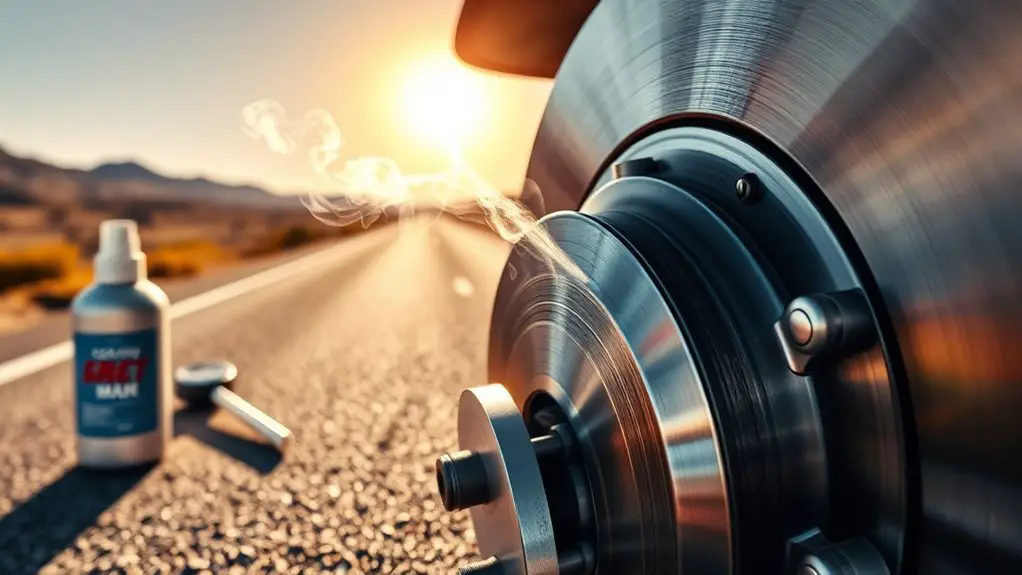
Although many drivers may not realize it, the driving conditions you encounter greatly affect brake temperature. The road surface plays a vital role; rough or uneven surfaces can increase brake friction, causing higher temperatures. Conversely, smooth surfaces may reduce friction but can still create heat during aggressive braking.
Weather conditions further complicate this relationship. In wet conditions, brakes can become less effective, leading you to press harder, generating excess heat. Conversely, extreme heat can cause brake components to expand, potentially resulting in reduced performance.
Additionally, driving in mountainous areas requires frequent braking, which can elevate temperatures markedly. Each of these factors contributes to the overall heat generated in your braking system, making it essential to adapt your driving style to the conditions. By understanding these impacts, you can take proactive measures to maintain ideal brake performance and avoid overheating.
Signs of Overheating Brakes to Watch For
As brake temperatures rise, certain signs can indicate that your brakes are overheating. One of the most immediate indicators is a brake warning light on your dashboard; if this illuminates, don’t ignore it. Additionally, monitor your temperature gauge; if it shows unusually high readings while driving, it could signal brake distress.
You may also notice a burning smell, often resembling burnt rubber or metal, which indicates excessive heat. Listen for unusual noises, such as squealing or grinding, as these can be signs of brake pad wear due to overheating.
Finally, pay attention to brake performance; if you experience reduced stopping power or a spongy brake pedal, it’s essential to address the issue immediately. Recognizing these signs can help you maintain your vehicle’s safety and performance, ensuring that your driving experience remains enjoyable and secure.
Maintenance Practices to Prevent Brake Overheating
To prevent overheating brakes, regular maintenance practices are vital. You should routinely check and replace your brake fluid, as it absorbs moisture over time, reducing its effectiveness. A fluid flush every couple of years guarantees peak performance. Additionally, keep an eye on your brake pads; replace them when they wear down to maintain proper stopping power and prevent overheating.
Here’s a quick maintenance checklist:
| Maintenance Task | Frequency |
|---|---|
| Brake Fluid Check | Every 6 months |
| Brake Fluid Flush | Every 2 years |
| Pad Inspection | Every oil change |
| Pad Replacement | As needed |
Upgrading Your Brake System for Enhanced Performance
Upgrading your brake system can greatly enhance your vehicle’s performance, especially if you’re frequently driving in demanding conditions. To achieve ideal braking efficiency, consider brake pad upgrades. High-performance pads are designed to withstand higher temperatures and provide better friction, reducing the likelihood of brake fade during intense usage.
Additionally, installing performance rotors can considerably improve heat dissipation, enhancing overall braking response. These rotors are typically constructed from advanced materials and feature designs that promote airflow, allowing them to stay cooler under pressure.
When choosing these components, always verify compatibility with your vehicle’s specifications to maximize performance benefits. Remember, an upgraded brake system not only improves stopping power but also contributes to a more responsive driving experience. Investing in these enhancements can lead to greater freedom on the road, allowing you to tackle challenging terrains and conditions with confidence.
Safe Driving Techniques to Reduce Brake Stress
While driving conditions can be unpredictable, employing safe driving techniques can greatly reduce brake stress and improve overall vehicle performance. To accomplish this, focus on smooth acceleration; gradually increasing speed minimizes strain on your brakes. Abrupt starts can lead to excessive heat buildup, increasing the likelihood of overheating.
Additionally, practice gentle deceleration. Instead of slamming on the brakes, allow your vehicle to coast to a stop when possible. This not only eases the burden on your braking system but also enhances fuel efficiency.
Maintain safe following distances, enabling you to react calmly to sudden stops without over-relying on your brakes. Regularly monitoring your driving habits guarantees you’re not just reacting to conditions, but proactively reducing brake stress. By integrating these techniques into your driving style, you’ll enjoy a more responsive vehicle and extend the lifespan of your braking system, all while preserving your freedom on the road.
Frequently Asked Questions
How Can I Tell if My Brake Fluid Is Overheating?
If your brake fluid’s boiling like a pot on the stove, it’s time to pay attention. Overheating symptoms include a spongy brake pedal, fading brakes, or a burning smell. If you notice any of these signs, it’s essential to check your brake fluid’s condition and level. Discolored or murky fluid can also indicate overheating. Don’t ignore these signs; they’re your vehicle’s way of warning you that something’s not right.
Does the Type of Brake Pad Affect Overheating Risk?
Yes, the type of brake pad can greatly affect overheating risk. Ceramic pads tend to dissipate heat more efficiently, reducing the chances of overheating during heavy use. In contrast, metallic pads can generate more heat due to their composition, potentially leading to increased overheating risks. If you’re seeking performance and longevity, consider your driving habits and choose the right pad type to optimize braking efficiency and minimize heat-related issues.
Can Weather Conditions Influence Brake Temperature?
Yes, weather conditions can greatly influence brake temperature. In hot weather, increased ambient temperatures can lead to higher brake temperatures, especially during heavy usage. Conversely, cold weather can create temperature variations, affecting brake performance. Wet or icy conditions may also require more braking force, generating additional heat. It’s crucial to take into account these weather effects on your braking system to guarantee peak performance and safety, regardless of the conditions you’re driving in.
Is It Normal for Brakes to Smell When Hot?
Yes, it’s normal for brakes to smell when they’re hot, akin to a blacksmith’s forge. This odor often signals overheating symptoms, indicating your brake components are working hard, especially during intense stops. However, if the smell persists or intensifies, it could point to brake maintenance issues, such as worn pads or insufficient fluid. Regular inspections can help you maintain the freedom of safe driving and prevent more serious brake problems down the road.
How Often Should I Check My Brakes for Overheating Issues?
You should check your brakes for overheating issues at least once a month, especially if you notice any overheating symptoms like unusual smells or sounds. Regular brake maintenance is vital for your safety and vehicle performance. If you drive frequently in heavy traffic or hilly areas, increase the frequency of your checks. Staying proactive helps guarantee that your brakes remain effective, giving you the freedom to drive confidently without worrying about potential failures.


